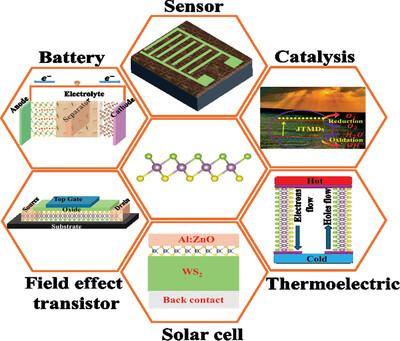Transition Metal Dichalcogenide Janus Monolayers 的物理和化学研究进展:特性、应用和未来展望
IF 2.9
4区 工程技术
Q1 MULTIDISCIPLINARY SCIENCES
引用次数: 0
摘要
杰纳斯过渡金属二钙化物(JTMDs)因其显著的物理和化学特征而备受科学界关注。本征偶极子的存在使它们有别于传统的过渡金属二钙化物。这些特性可用于各种潜在应用,包括储能、发电和其他电子设备。JTMD 被认为是二维(2D)材料研究的热门话题,因此有必要了解它们的基本特性以及在各种应用中的潜在用途。本综述涵盖了 Janus 与传统过渡金属二钴基二维材料的根本区别。讨论包括单层、双层和多层材料的特性,重点是它们的结构稳定性、电子特性、光学特性、压电性和拉什巴效应。此外,还讨论了应变和电场等外部刺激对单层 JTMD 基态特性工程学的影响。此外,还重点介绍了 Janus 单层材料的各种潜在应用,包括气体传感器、催化、电化学储能、热电、太阳能电池和场效应晶体管,并强调了提高其性能的重要性。最后,还强调了 Janus 二维材料在下一代电子器件中的应用前景。本文章由计算机程序翻译,如有差异,请以英文原文为准。

Advances in Physics and Chemistry of Transition Metal Dichalcogenide Janus Monolayers: Properties, Applications, and Future Prospects
Janus transition metal dichalcogenides (JTMDs) have garnered significant interest from the scientific community owing to their remarkable physical and chemical features. The existence of intrinsic dipoles makes them different from conventional transition metal dichalcogenides. These properties are useful in various potential applications, including energy storage, energy generation, and other electronic devices. The JTMDs are considered a hot topic in two dimensional (2D) materials research, making it necessary to understand their fundamental properties and potential use in various applications. This review covers the fundamental difference between Janus and conventional transition metal dichalcogenide‐based 2D materials. This discussion encompasses the characteristics of monolayer, bilayer, and multilayer materials, focusing on their structural stability, electronics properties, optical properties, piezoelectricity, and Rashba effects. The impact of external stimuli such as strain and electric field toward engineering the ground state properties of monolayer JTMDs is discussed. Additionally, various potential applications of Janus monolayers, including gas sensors, catalysis, electrochemical energy storage, thermoelectric, solar cells, and field effect transistors, are highlighted, emphasizing enhancing their performance. Finally, the prospects of Janus 2D materials for next‐generation electronic devices are highlighted.
求助全文
通过发布文献求助,成功后即可免费获取论文全文。
去求助
来源期刊

Advanced Theory and Simulations
Multidisciplinary-Multidisciplinary
CiteScore
5.50
自引率
3.00%
发文量
221
期刊介绍:
Advanced Theory and Simulations is an interdisciplinary, international, English-language journal that publishes high-quality scientific results focusing on the development and application of theoretical methods, modeling and simulation approaches in all natural science and medicine areas, including:
materials, chemistry, condensed matter physics
engineering, energy
life science, biology, medicine
atmospheric/environmental science, climate science
planetary science, astronomy, cosmology
method development, numerical methods, statistics
 求助内容:
求助内容: 应助结果提醒方式:
应助结果提醒方式:


